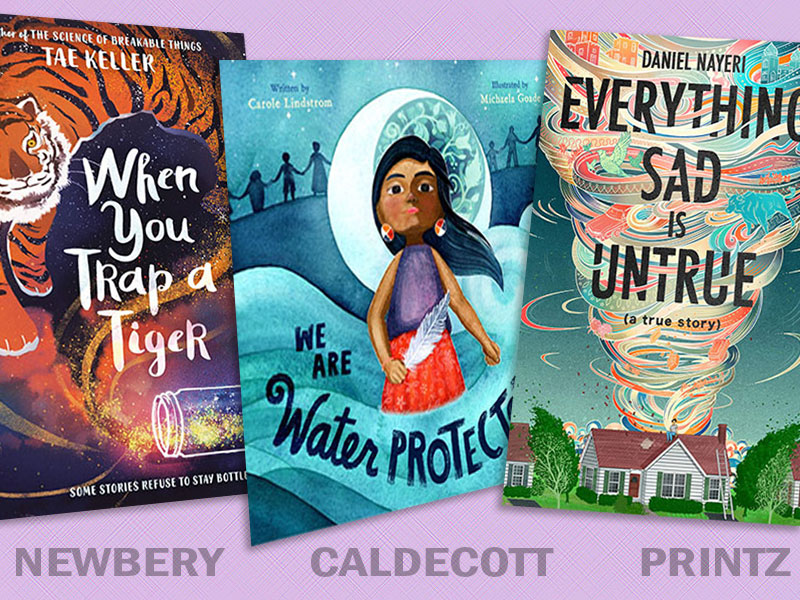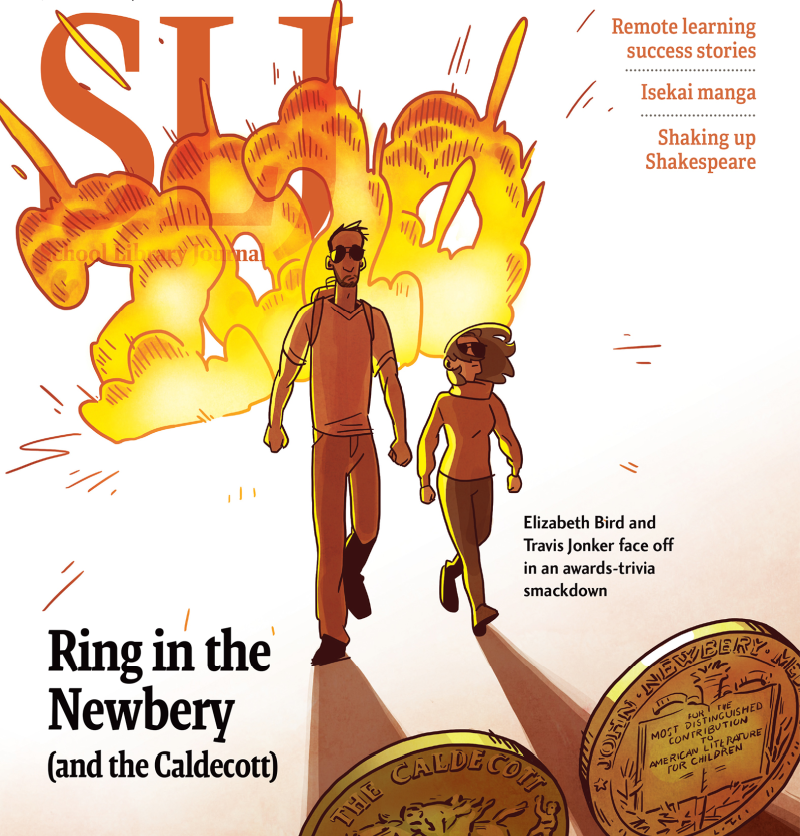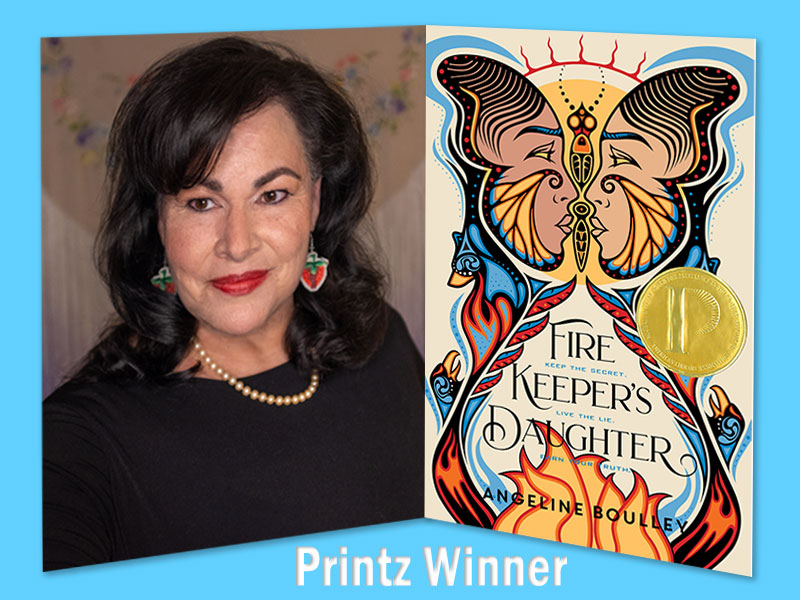The Message of Ms. Liberty’s Foot
 My county library system catalog lists 34 nonfiction books about the Statue of Liberty. I think I’ve actually only read one (Lynn Curlee’s, which was excellent), but I’m pretty confident that none of them resembles HER RIGHT FOOT in terms of style, presentation of information, or interpretation of theme. It starts out light and conversational:
My county library system catalog lists 34 nonfiction books about the Statue of Liberty. I think I’ve actually only read one (Lynn Curlee’s, which was excellent), but I’m pretty confident that none of them resembles HER RIGHT FOOT in terms of style, presentation of information, or interpretation of theme. It starts out light and conversational:
“You have likely heard of a place called France….You may have also heard of something called the Statue of Liberty. Did you know that the Statue of Liberty comes from France? This is true. This is a factual book.”
ADVERTISEMENT
ADVERTISEMENT
I wasn’t sure about this voice at first. Is it playful and inviting? Or just kind of patronizing? I got used to it pretty quickly, though, more so when interesting facts were introduced. We learn interesting stuff about the statue’s creation: how smaller models were used, how it was constructed, and transported…all pretty fascinating. The author continues to address the reader along the way.
“Ask your friends and even your teachers if they knew that before the Statue of Liberty was assembled in New York, she was first constructed in Paris. Your friends and teachers will be astounded. They will be impressed. They might think you are fibbing. But you are not fibbing. This really happened.”
The illustrations do a lot to support the tone, but even without them the voice is distinct and consistent. There are a few spots where the pictures do carry more of the load. A reference to “rare Nico records,” for example, is one that few kids (and not that many adults) will get, but it works to set up a humorous illustration of the statue stopping at a record store, and most everyone will get the idea.
Then about halfway through, there’s a shift: “But there is one thing that you might not know, and this is the central point to this book – a point the author apologizes for taking so long to get to.” Then we learn that the statue’s right foot is lifted, as if she’s striding: “This 150-foot woman is on the go!”
ADVERTISEMENT
ADVERTISEMENT
After inviting us to reflect upon that, he get to his theme: “Here is an idea. Here is a theory. Here is a reminder.” Then comes some pointed, serious words about how courage and action are required for “liberty and freedom from oppression.” “After all, the Statue of Liberty is an immigrant, too. And this is why she’s moving…she is not content to wait. She must meet them in the sea.” [I’m skipping around a bit here with my quotes, hoping to still convey the sense of it]
So it’s not just a fact book with funny bits after all. It’s a persuasive argument with a distinct point of view. You don’t see that too often in children’s non-fiction. The first half that invites us in and presents interesting information serves as a potent set-up for the big message at the end. The interplay between the irreverent tone in the first half and the more heartfelt closing passages balance each other to some degree, so it doesn’t ever quite seem either too light or too strident.
The Newbery Terms and Criteria note that the award “is not for didactic content.” I read that as a reminder that we can’t reward or condemn a book because we like or dislike the message…but it certainly doesn’t warn us away from books that aim to teach or inspire. Instead, we have to stay focused on the way messages are delivered through the writing and how that execution (or “interpretation of the theme” as the Terms and Criteria put it) might contribute to literary excellence.
There were a few moments when the author’s voice felt overly intrusive and took me out of the book’s world. I’d take a hard second look at that aspect before I nominated this one, trying especially to understand how those moments would work with a child reader. Overall, though, I think HER RIGHT FOOT is a good example of a book that delivers facts and themes in a creative, and even innovative form that’s engaging and pretty powerful.
Filed under: Book Discussion
About Steven Engelfried
Steven Engelfried was the Library Services Manager at the Wilsonville Public Library in Oregon until he retired in 2022 after 35 years as a full-time librarian. He served on the 2010 Newbery committee, chaired the 2013 Newbery Committee, and also served on the 2002 Caldecott committee. You can reach him at sengelfried@yahoo.com.
ADVERTISEMENT
ADVERTISEMENT
SLJ Blog Network
2024 Books from Pura Belpré Winners
In Memorium: The Great Étienne Delessert Passes Away
Winnie-The-Pooh | Review
Parsing Religion in Public Schools
Finding My Own Team Canteen, a cover reveal and guest post by Amalie Jahn
ADVERTISEMENT








Steven, I think you’ve spotlighted what makes this book unique. The cheekiness of the narrator draws the reader into some fairly dense facts and then balances the directness of the “message”. Kind of like adding a chirping piccolo to strident violin strings. A good choice to discuss for Newbery.
Have you had a look at the text for HOW TO BE AN ELEPHANT. The voice in that book is engaging as well.
I agree, DaNae, HOW TO BE AN ELEPHANT was very well done. As with GIVE BEES A CHANCE, I really appreciate authors who try to share basic facts in creative ways.
Has anyone else read Fault Lines of the Constitution by Cynthia Levinson and Sanford Levinson?
Like Right Foot, it is a book of opinion. I think one could argue that it is very distinguished in both presentation of information, interpretation of the concept, and appropriateness of style.
The purpose is obviously didactic but as long as the committee isn’t awarding the book because of the content then I think it is a real contender. In terms of doing what it set out to do, Fault Lines is very high on my list.
Thanks for the Fault Lines recommendation, Eric. It’s on my to-read pile, and I’ll move it towards the top. Levinson’s “We’ve Got a Job” from a few years ago was excellent!
I have Her Right Foot fairly high on my list at this point. It’s a unique and engaging book. My students are hooked from the opening pages about France. The author’s direct voice and cheeky asides are a delight to follow; the shift to today’s immigrants and refugees adds depth and significance to the work that may have at first felt glib. This just might be the year where an uncommon surprise like Her Right Foot gets a chance to shine.
Thanks for pointing me toward Fault Lines and How To Be an Elephant too! I’ll take a look at them with my Newbery glasses on.
I will join in with the enthusiasm for this one. I read it aloud to my 4th graders and the direct voice worked wonderfully well. They agreed with me that it had Newbery potential all over it. Not allowed at the RC table, but it made me think for some reasons(Eiffel Tower, I guess) of a favorite of mine, Greg Pizzoli ‘s Tricky Vic. All those witty factoids.
Yes. I agree with Steven’s astute evaluation of this book and what makes it distinctive. It’s been a bit since I first read it, but it lingers with me. The simple directness of the message reverberates, never letting me forget that this book is much more than it could have been. Does that make sense? Let me try again another way. This book could have been lovely if it had “only” conveyed great historical information in a fun and engaging way. By doing more, by taking us somewhere we didn’t expect (but that seems utterly right and true once we’re there), it is elevated. My friends who teach history know that we study the past at least in part to understand and inform the present but also to engage with the future. This book does exactly that.
I loved this one. It was interesting to me, though, that one librarian friend absolutely hates it. I think she did use the word “patronizing.” And she thought the Nico Records reference was ridiculous. Trying to be hip? Her reaction makes me wonder how many haters there’d need to be to keep this book from doing well in the voting.
Personally, I think his is such a refreshing voice for children’s nonfiction. (I also loved THIS BRIDGE WILL NOT BE GRAY last year.) Why should we always use a teacher voice? Why should we always get serious about nonfiction? “Presentation for a child audience” is outstanding. And the information is presented clearly and memorably.
Alas, Sondy, like your librarian friend, I’m having a tough time moving through this one.
I admit, though, that I have a bias against Eggers. I find his writing (for adults, anyway) smug and pretentious and self-satisfied, and I’m working very hard to remove that bias to read this children’s book. That authorial voice of his that I loathe so much kept poking into my cerebral cortex, and I put the book down. I am not proud of this. I should be able to dispose of my bias and move through this like an adult.
I’ll pick it up again, but I’m already steeling myself for the generous *huff* I’ll likely produce when I get to the Nico part. Oh, gosh. There I go again. :/
Joe, I feel the same way about Eggers’ work for adults. But somehow this hit me the right way. No condemnation if you huff though.
Question: did anyone else have a similar reaction to the Robert Frost poem in I’M JUST NO GOOD AT RHYMING? I think I actually happened to be 12 when first exposed to “The Road Not Taken” but in general the joke hardly works unless one happens to be familiar with the specific reference. I think its inclusion is symptomatic of the same thing that motivated the Nico reference – I would say in both books you have a clever, adult writing voice (that trades easily in such references) aimed at, but not impeccably scrupulous about considering, the child audience.
So, yes, that Nico reference. It’s one line, and as I tried to convince myself in the introduction, the artwork makes the joke work anyway, so just let it go, Steven. It’s fine, and often even a good thing, when an author can appeal to the child reader/listener and the adult who might be reading aloud to the child. And because the author’s voice, to this point at least, has been light and playful, one offhand joke that doesn’t make sense does not seem so out of place. But…I’m still struggling to let it go. it’s so clearly a throwaway line meant to amuse a very specific type of adult reader. It could so have been dropped or adapted (“rare Beatles record” would have been less distracting, though not at all amusing to the readers that would enjoy a Nico reference).. A great strength of the book is the careful way it moves from the lighthearted first half towards the passionate statements at the end, and this moment, coming just before the shift, seems ill-timed and distracting. It seems nitpick-y, but in a book with not that many words and a narrative that progressively leads to a clear and powerful “central point,” a slight disruption can have an impact. I’m still not sure myself: does the line distract the readers who don’t get it, or does in not matter at all and they still get the full essence of everything else?
To be honest I am an adult for whom the Nico reference meant nothing. (Can’t remember it — was it Nico from Velvet Underground or someone else?) I think the references can be taken in so many ways. We get the Road Not Taken, but a kid not knowing it may still appreciate the poem. Makes me think over and over of Lewis Carroll (whose life and times and work I know intimately) and his parodies. Today most do not know the original works he was making fun of, but still enjoy the poetry.
I think child readers are used to not getting everything, especially in a book like this. If they read it, they are going to get some stuff and not others. Some that they don’t get may be the Nico or Frost reference or the more melancholy verses or something else. But I don’t think that matters. The gestalt will still work for those into a snarky witty verse. (And again, this to me is not Shel Silverstein-ish as much as Carroll, Nash, and Lear.)
Oops, just realized I was conflating this book with the RHYMING book (because someone above referenced the Frost parody). But my initial response to the Nico reference in the Eggers still stands. Noticed it, figured it was some quirk on the author not knowing what it was, and moved on. The kids I read it to didn’t seem interested in knowing more either. Does seem a bit self-indulgent, but no fatal flaw to me.
I know we are way past this discussion but I’m going to add this to the record. I’ve spent a week reading HER RIGHT FOOT to a number of classes. A book that can be read a number of time and still feels good on the tongue is a rare animal. I’m get a shiver of delight every time I get to certain passages.
“. . .even if you have seen a picture of the Statue of Liberty, or many pictures of the Statue of Liberty, or even hundreds of pictures of the Statues of Liberty, you probably have not seen pictures of her feet.”
I love how the repetition here builds excitement to the introduction of the book’s theses. I’ve seen a few students start bouncing in their seats in anticipation.
The page I truly find illuminating and spectacular is towards the end:
“The Statue of Liberty was not built to welcome just 1,886 immigrants from Italy on one certain Sunday in, say, 1886.
No! she was built to welcome 3,000 immigrants from Poland the next day.
The next day, 5,000 Norwegians/
After that, 10,000 Glaswegians.
Then Cambodians.
Then Estonians.
Somalis. Nepalis.
Syrians. Liberians.”
Such mastery of language. Chills. Every. Single. Time.
This works with many grades. With the younger ones we can discuss the idea of metaphor and with my older, sixth graders, we discuss the switch between a fact based book and opinion.
However the part that confuses me every time, not the NY references, but why does he say she is facing Southwest then switch to Southeast? Does she move? Is it a misprint the first time? Does he just want to put a Trenton reference in?